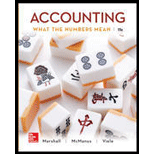
a.
Concept Introduction:
Return on Investment = Net Income / Average Total Assets
Note: Average total assets are calculated as an average of beginning and ending total assets. The formula to calculate the average total assets is as follows:
To Calculate:
The interest earned on the savings account for six months.
b.
Concept Introduction:
Return on Investment: The Return on Investment is the profitability ratio that measures the percentage of profit earned on average assets invested in the business. Return on assets is calculated by dividing the net income by average total assets. The formula to calculate Return on assets is as follows:
Return on Investment = Net Income / Average Total Assets
Note: Average total assets are calculated as an average of beginning and ending total assets. The formula to calculate the average total assets is as follows:
To Calculate:
The
Concept Introduction:
Return on Investment: The Return on Investment is the profitability ratio that measures the percentage of profit earned on average assets invested in the business. Return on assets is calculated by dividing the net income by average total assets. The formula to calculate Return on assets is as follows:
Return on Investment = Net Income / Average Total Assets
Note: Average total assets are calculated as an average of beginning and ending total assets. The formula to calculate the average total assets is as follows:
The decision on investment.
Want to see the full answer?
Check out a sample textbook solution
Chapter 3 Solutions
Accounting: What the Numbers Mean
- You are posting questions and giving unhelpful i am also positing you can give my answer i will not give unhelpful but If you unhelpful my answer then I will unhelpful your answer. Also you know unhelpful will remove after coureshero review. So coperate.arrow_forwardPlease provide the answer to this general accounting question using the right approach.arrow_forwardI need answer ✅arrow_forward

 AccountingAccountingISBN:9781337272094Author:WARREN, Carl S., Reeve, James M., Duchac, Jonathan E.Publisher:Cengage Learning,
AccountingAccountingISBN:9781337272094Author:WARREN, Carl S., Reeve, James M., Duchac, Jonathan E.Publisher:Cengage Learning, Accounting Information SystemsAccountingISBN:9781337619202Author:Hall, James A.Publisher:Cengage Learning,
Accounting Information SystemsAccountingISBN:9781337619202Author:Hall, James A.Publisher:Cengage Learning, Horngren's Cost Accounting: A Managerial Emphasis...AccountingISBN:9780134475585Author:Srikant M. Datar, Madhav V. RajanPublisher:PEARSON
Horngren's Cost Accounting: A Managerial Emphasis...AccountingISBN:9780134475585Author:Srikant M. Datar, Madhav V. RajanPublisher:PEARSON Intermediate AccountingAccountingISBN:9781259722660Author:J. David Spiceland, Mark W. Nelson, Wayne M ThomasPublisher:McGraw-Hill Education
Intermediate AccountingAccountingISBN:9781259722660Author:J. David Spiceland, Mark W. Nelson, Wayne M ThomasPublisher:McGraw-Hill Education Financial and Managerial AccountingAccountingISBN:9781259726705Author:John J Wild, Ken W. Shaw, Barbara Chiappetta Fundamental Accounting PrinciplesPublisher:McGraw-Hill Education
Financial and Managerial AccountingAccountingISBN:9781259726705Author:John J Wild, Ken W. Shaw, Barbara Chiappetta Fundamental Accounting PrinciplesPublisher:McGraw-Hill Education





